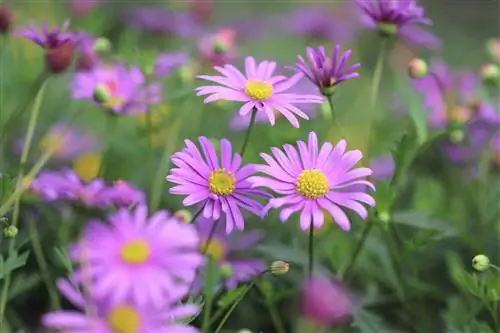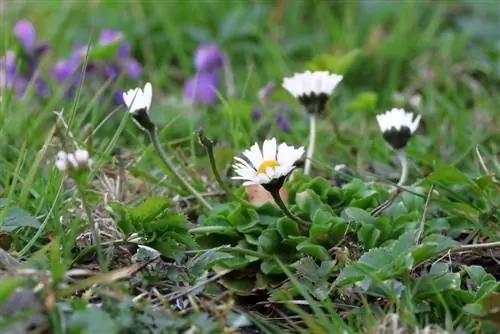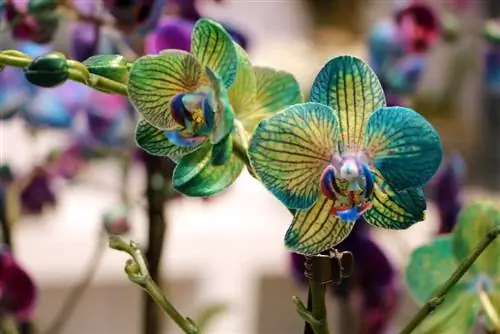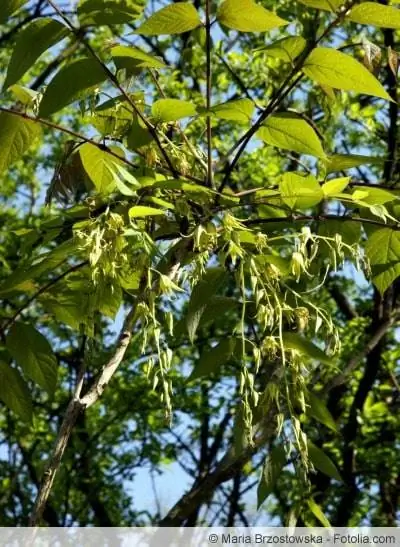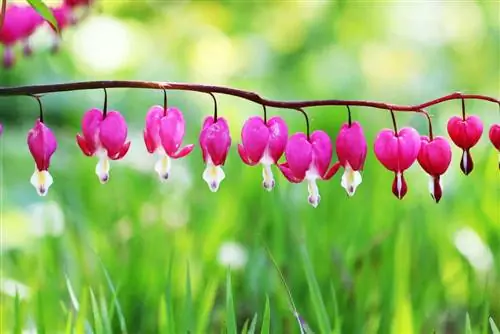- Author admin [email protected].
- Public 2023-12-17 03:39.
- Last modified 2025-01-24 12:45.
The blue daisy is a delicate beauty. It is a wildflower native to Australia and has little in common with our daisies. Just like daisies, asters and chrysanthemums, the small 'Brachyscome iberidifolia' is a composite family. In contrast to the daisies native here, the blue daisy is not hardy. It is one of the annual flowers.
This blue beauty is very popular as an ornamental plant because it blooms in beds and hanging baskets continuously from May until the first frost. Care also does not place any special demands on the hobby gardener. She is quite undemanding and modest. A recommended addition to the terrace, balcony and garden. The blue daisy exudes an intense and very pleasant scent. That's why the flowers are often cut in order to spread a feeling of well-being in the vase in the house.
Profile
- Area of life: summer flowers, annual
- Growth height: 20 to about 40 cm
- Flowering time: from May to October
- Flower color: blue
- Foliage: green, pinnate
- Location: Sun to partial shade
- Growth: herbaceous
- Use: Summer planting in borders, terraces, balconies, hanging baskets
- Soil: nutrient-rich, humus, permeable
- Frost: not frost hardy
- Normal germinator
- Origin: Australia
Location
The space in the garden bed should not be too dark for the blue daisy. The plant needs sun or partial shade to develop optimally. In dark, shaded locations, growth slows down and only a few flowers are produced. If the blue daisy has been assigned the right location, it will grow and thrive magnificently and delight in lush blooms from May to October. The blue daisy is very popular as a container and hanging basket plant. Because the lush floral flora brings radiant beauty to the balcony and terrace. A planter planted with an otherwise bare standard tree can become a visual highlight in any location when transplanted with blue daisies, for example.
The 'Brachyscome iberidifolia' does not place great demands on location and care, neither in the bed nor in containers or hanging baskets. In an airy place in sun or partial shade and in permeable, nutrient-rich and humus-rich soil, the blue daisy delights the gardener with lush growth and rich flowers. The blue daisy is not sensitive to wind. If the location is right, the blue daisy presents itself in beautiful blooms from May to October.
The seeds can be sown widely and directly on site. The best time for this is April. The seeds germinate within 1 to 2 weeks at 15 to 20 °C. Sowing in seed trays at temperatures of around 20 °C also achieves good germination success. The soil in the garden bed as well as in the plant pot or balcony box must be well-drained. The otherwise undemanding plant cannot tolerate waterlogging at all. Potting soil for pots and hanging baskets can, if necessary, be mixed with expanded clay or sand to achieve good permeability. In addition to the blue daisy, other species and varieties with purple, white or violet flowers are commercially available.
Care
The blue daisy is also undemanding when planted in containers. It only needs a little water on the balcony and terrace, but it does need water regularly. The root ball must never dry out completely. Waterlogging causes considerable damage to the small plant. Therefore, the water from the coasters must be removed immediately. It does not place any greater demands on the gardener's skills. This makes it recommended even for beginners.
The 'Brachyscome iberidifolia' does not need to be pruned in the bed, as well as on the balcony and terrace. Regularly removing withered flowers and dead plant particles increases growth and flowering. The blue daisy is very sensitive to cold. The plant dies with the first frost. Next spring new seeds will be sown in place and the blue blossoms for the season can begin.
Fertilizer
The blue daisy only needs a little fertilizer. It is sufficient to give a dose of normal flower fertilizer with sufficient iron content every 2 to 4 weeks.
Wintering
The blue daisy 'Brachyscome iberidifolia' is not winter hardy. You can try overwintering indoors at temperatures between 6 and 15 °C in a bright location. Other varieties, such as 'Brachyscome multifida', are suitable for overwintering. Since the seeds of 'Brachyscome iberidifolia' quickly grow into new, lushly flowering plants, the question arises as to whether trying to overwinter is even worth it.
Propagation
The blue daisies are very easy to propagate by sowing them in March. However, the plants are only allowed on the balcony or in the bed when the ice saints are over. A temperature of 20 to 22 °C is required for the seeds to germinate. A mini greenhouse can be very helpful here. Once the last frosts have passed, the plants are placed in their final location. To ensure optimal growth, the plants need a distance of 15 to 20 cm. After just a short time the wax and flower miracle begins again.
Diseases & Pests
In rare cases, the whitefly can attack the blue daisy as a pest. An infestation can be recognized by the following characteristics.
- white dots appear on the underside of leaves
- affected leaves become mottled and yellow, sticky and fall off
- fine webs appear on the undersides of the leaves
Help comes from the immediate removal of infected shoots. Infected plant parts do not belong in the compost or in the household waste.
Tip:
Put affected plant parts in a plastic bag and fill with soapy water. Seal the bag airtight and dispose of the dead whiteflies later.
Nothing is known about any diseases that can affect the blue daisy. They are so rare that they don't need mention.
Frequently asked questions
My blue daisy's leaves are turning completely yellow. What am I doing wrong?
Check whether waterlogging has occurred. Over-fertilization or iron deficiency also shows this damage. The plant should be fertilized very sparingly with an 'iron-containing' fertilizer at most every 2 weeks.
How can I overwinter the blue daisy?
The blue daisy 'Brachyscome iberidifolia' is a pure summer flowering plant. It dies immediately in the event of frost. You can try overwintering indoors at temperatures between 6 and 15 °C in a bright location. However, it is not certain whether the attempt will be successful
What you should know about the blue daisy in brief
- The blue daisy is usually cultivated as an annual.
- It is vulnerable to wind and should be planted sheltered, ideally in full sun.
- It is also suitable as a balcony and hanging plant.
- A permeable, preferably drained, nutrient-rich soil is suitable.
- Addition of stable manure and fine-grained pumice stone is beneficial.
- The daisy does not need much water. It needs to be watered regularly, but not much.
- Ball dryness is just as harmful as waterlogging.
- It is recommended to water every two weeks with a flower fertilizer containing iron.
- If dead flowers are removed regularly, the plant will continue to bloom vigorously.
- In mild regions it is possible to overwinter the flower outside. However, it should be covered with brushwood.
Propagate
Propagation occurs by sowing in trays in a permeable, sandy substrate. This must be kept evenly moist. To germinate, the seeds are only slightly covered. 2 to 3 seedlings are transplanted into a 7-8 cm pot. The best time to sow is between February and April. After the Ice Saints, the plants can be planted out. The planting distance should be around 15 cm. You can also try sowing the blue daisy directly on site. This can happen from the end of April. The seeds are sown widely. It is also possible to propagate the daisy using head and partial cuttings. The best time for this is April. The prerequisite is that you manage to overwinter a plant. Since the daisy is very sensitive to cold, this can only be done indoors or in a heated greenhouse.

